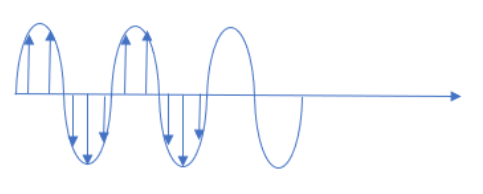
The waves in which the particles of the medium vibrate in a direction perpendicular to the direction of wave motion is known as:
A. Transverse wave
B. Propagated waves
C. Longitudinal waves
D. Stationary waves
Answer
512.7k+ views
Hint: Wave is a vibration or disturbance in space. This vibration causes a propagated pattern of wave. According to how the particles are moving, waves can be classified into transverse and longitudinal waves.
Complete step-by-step answer:
If the particles are moving perpendicular to the motion of the wave, then the wave is known as transverse waves. The following diagram represents the motion of waves and particles motion.
Hence the correct option is A.

Additional information:
Transverse and longitudinal waves are under the category of mechanical waves. They need a medium for the propagation. Water waves, sound waves and seismic waves are the examples for this.
Transverse waves: It occurs when the individual particles or segments of a medium vibrate from side to side perpendicular to the direction in which the direction of propagation of wave.
Longitudinal waves: Unlike transverse waves, the longitudinal waves occur when the individual particles of a medium vibrate back and forth in the same direction of waves propagation. They are most common in the springs. It will generate due to the pushing or pulling of the spring.
Stationary waves: Stationary waves also known as standing waves. These waves are a combination of two waves of the same frequency. So, the interference will occur. Their wave velocity is zero. These waves will be in the same phase. It doesn’t carry energy with the waves.
Note: All other waves have their own characteristic properties. Longitudinal waves are the waves in which the particles are moving with the same direction of the propagation of waves. Standing wave is a superposition of waves of similar frequency. Propagated waves are implying the way in which the wave travels.
Complete step-by-step answer:
If the particles are moving perpendicular to the motion of the wave, then the wave is known as transverse waves. The following diagram represents the motion of waves and particles motion.
Hence the correct option is A.

Additional information:
Transverse and longitudinal waves are under the category of mechanical waves. They need a medium for the propagation. Water waves, sound waves and seismic waves are the examples for this.
Transverse waves: It occurs when the individual particles or segments of a medium vibrate from side to side perpendicular to the direction in which the direction of propagation of wave.
Longitudinal waves: Unlike transverse waves, the longitudinal waves occur when the individual particles of a medium vibrate back and forth in the same direction of waves propagation. They are most common in the springs. It will generate due to the pushing or pulling of the spring.
Stationary waves: Stationary waves also known as standing waves. These waves are a combination of two waves of the same frequency. So, the interference will occur. Their wave velocity is zero. These waves will be in the same phase. It doesn’t carry energy with the waves.
Note: All other waves have their own characteristic properties. Longitudinal waves are the waves in which the particles are moving with the same direction of the propagation of waves. Standing wave is a superposition of waves of similar frequency. Propagated waves are implying the way in which the wave travels.
Recently Updated Pages
A man running at a speed 5 ms is viewed in the side class 12 physics CBSE

The number of solutions in x in 02pi for which sqrt class 12 maths CBSE

State and explain Hardy Weinbergs Principle class 12 biology CBSE

Write any two methods of preparation of phenol Give class 12 chemistry CBSE

Which of the following statements is wrong a Amnion class 12 biology CBSE

Differentiate between action potential and resting class 12 biology CBSE

Trending doubts
What are the major means of transport Explain each class 12 social science CBSE

Which are the Top 10 Largest Countries of the World?

Draw a labelled sketch of the human eye class 12 physics CBSE

How much time does it take to bleed after eating p class 12 biology CBSE

Explain sex determination in humans with line diag class 12 biology CBSE

Explain sex determination in humans with the help of class 12 biology CBSE




